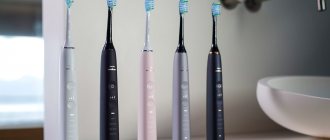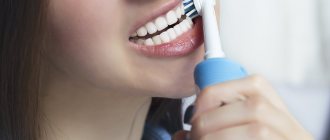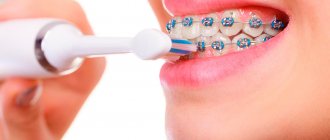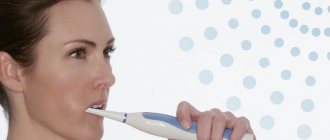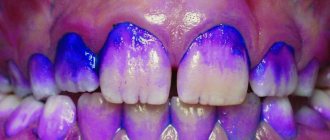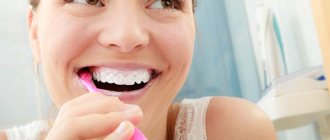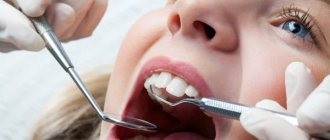It has been proven that using an electric toothbrush allows you to brush your teeth daily much more effectively than using a regular brush. The modern device cleans tooth enamel even in the most difficult to reach places and provides a cleaning quality close to professional. It is not surprising that such devices are used in dental clinics.
However, before you start using an electric toothbrush at home, you need to carefully read the rules and nuances of using the device.
Advantages of the device
Electric toothbrushes have many benefits:
- This device provides a whole range of possibilities for cleaning, massage and care of the oral cavity.
- Moving bristles and several operating modes facilitate and speed up the cleaning process, and also allow you to thoroughly clean interdental spaces and hard-to-reach places, such as “sevens” and “eights.”
- Electric brushes make it much easier to care for orthodontic braces.
- Electric brushes deal with stains from tea or coffee 21% better than a regular manual brush, and with gingivitis - about 11%.
- Using an electric brush prevents the possibility of injury to the gums or destruction of enamel. Provided proper operation and the correct choice of attachments, cleaning with this device is less traumatic.
- Children love brushing their teeth with a children's electric toothbrush. This makes the boring morning ritual interesting for them and they perform it with more enthusiasm.
Important! If you decide to purchase an electric toothbrush, then don’t skimp. Remember, a high-quality device cannot be cheap. The price of branded models starts from 7 thousand rubles. By choosing a cheaper device, you risk buying a fake, which can quickly break down, or, even worse, harm your health.
Which toothbrush is better to choose - electric or ultrasonic?
Of all the varieties, ultrasonic brushes are considered the most effective in terms of whitening and disinfection. There are several main advantages of such models.
- Most ultrasonic devices combine 2 methods of exposure - high-frequency radiation and intense vibration up to 100,000 revolutions. Thanks to this, the maximum quality of dental treatment is achieved. Even if the device’s fibers do not reach hard-to-reach places, ultrasound penetrates into all recesses and crevices and destroys deposits.
- The devices have a beneficial effect on blood circulation in the oral cavity. If you use them on a regular basis, the gums will quickly become stronger, the manifestations of periodontal disease will decrease, and the “pockets” in the soft tissues in the cervical area will become smaller. The impact of ultrasound can be compared to a high-quality massage, only the effectiveness of high-frequency vibrations is higher, despite the lack of physical impact.
- Brushes of this type help fight infectious and bacterial processes. Ultrasound radiation suppresses the activity of microorganisms and acts as a high-quality antiseptic. When using the device, you don’t have to worry that after each meal, microbes will multiply in the gaps between your teeth and gum pockets. Ultrasonic devices slow down the development of caries and prevent periodontal disease and pulpitis.
- Brushes that support high-frequency ultrasound radiation quickly return teeth to a uniform white shade, even with frequent consumption of coffee and tea or smoking. The enamel is not destroyed during the process, but after dental whitening, the teeth often become very sensitive.
Ultrasonic electric brushes help disinfect teeth and gums
At first glance, it seems that the advantages of ultrasonic brushes are completely obvious. But they also have some disadvantages.
- High price. In the ranking of sonic electric toothbrushes, high-frequency models will be the most expensive.
- Negative impact on any artificial elements in the oral cavity. Ultrasound has a bad effect on dentures, crowns and even regular fillings and shortens their service life.
Thus, ultrasonic brushes will be optimal for a healthy dentition; they will protect the enamel from destruction and prevent the development of bacterial processes. But if you have implants, braces and numerous fillings, it is better to consult a doctor about the advisability of using the device. Most likely, the dentist will advise you to opt for a mechanical electric brush; it will be the safest.
Contraindications for use
In addition to the benefits and pleasure of use, electric brushes also have a number of contraindications and disadvantages :
- Before you start using the device, it is advisable to obtain the approval of your dentist, who will evaluate the condition of your teeth. You will also receive the necessary advice and recommendations.
- Those people who have sore or weak gums are not recommended to use an electric toothbrush every day. You can alternate it with a manual analogue and monitor your well-being.
- Thin, sensitive enamel can also be damaged by thorough cleansing with an electric brush.
- The use of an electric toothbrush is contraindicated for people with serious heart disease.
- The main disadvantage of the device is the high cost of the device itself and the attachments, which must be changed regularly.
Effective and gentle sound cleaning
An electric toothbrush with sonic technology works as follows. The device has a high-frequency generator that creates sound waves and causes the bristles of the cleaning head to vibrate. The frequency and amplitude of the vibrations ensure that the liquid from the paste, water and saliva circulates in the mouth and is saturated with oxygen bubbles.
Due to circulation, the tooth is washed from all sides, dirt is washed away and the paste penetrates into hard-to-reach areas; bursting air microbubbles provide not only a cleaning, but also a disinfecting effect, destroying bacteria on the teeth, gums and in the interdental spaces. The cleaning effect is enhanced by the movement of the cleaning head, which moves up and down or in a reciprocal rotational manner.
Thus, the mechanism of action of the brush is based not only on sound waves, but also on traditional mechanical cleaning - the friction of the bristles on the surface of the tooth. Liquid with microbubbles cleans difficult areas, spaces between teeth, gum edges, periodontal pockets, and the sweeping movements of the head thoroughly remove plaque from the surface of the enamel. This complex effect enhances the hygienic effect and allows you to remove maximum dirt and germs from the oral cavity.
How to cleanse correctly?
Some people believe that an electric toothbrush will do all the work for them. This is true, but only partly. There are important nuances in using this electrical appliance.
Preparation for the procedure
Before starting work, you need to understand the types of nozzles and the mode necessary for cleaning. Most devices have 4 operating modes :
- teeth cleaning;
- polishing;
- whitening;
- sensitive;
You also need to monitor the battery charge or battery charge level. It is optimal to charge the device once a week; as a rule, this is enough. It is convenient to have the charger next to the sink, but charging must be done in a safe manner.
After you have moistened the bristles with water, you can squeeze out a little toothpaste, a pea-sized ball of paste will be enough, and press the button to turn on the device.
Information . Some manufacturers of hygiene products claim that their use is quite possible without toothpaste. However, we recommend not limiting yourself to just one device, but using it together with a paste, irrigator and rinse aid.
Instrument position
Conditionally divide the oral cavity into 4 areas - upper, lower, right and left. You will need to allocate 30 seconds of brushing to each area. The hand should be held at a 45° angle to the gum line, and the brush should be positioned along the front surface of the teeth.
Cleaning the Exterior
Simply guide the working part of the brush, stopping at each tooth for a few seconds. Clean easily, without pressing , the device will do its job on its own.
Some models are equipped with a sensor that is activated when the brush pressure is excessive. Over time, you will learn to control the force of pressing. The external cleaning procedure covers the entire tooth surface, right down to the gums.
Inner surface
Repeat the manipulations not only outside, but also inside. For greater convenience, the device can be rotated vertically. Pay attention to chewing surfaces and interdental spaces. Gently walk over the surface of your tongue. This will help remove even more bacteria and freshen your breath.
Important! Due to the correct pressure and position of the head of the device, a light massage of the gums will be carried out. You just need to install the desired nozzle.
Completing the procedure
For an effective cleaning process, do not increase or decrease the time programmed by the device. As a rule, this is 2 minutes per brushing.
At the end of the hygiene procedure, all that remains is to rinse your mouth with water or a special mouth rinse. Then you need to thoroughly rinse the working part of the brush under running water and set it to dry with the bristles facing up. If you have a sterilizer, then it would be a good idea to treat the attachments to eliminate possible bacteria from their surfaces.
Differences and advantages of sound
A sonic brush , unlike an ultrasonic one, does not create additional wave beat, and the vibration speed is an order of magnitude lower.
Keep in mind! The advantages of a sonic brush are:
- Effective removal of plaque , even “old” plaque.
- The vibrating movements of the brush help to gently remove food debris , and at the same time massage the gums to improve blood supply.
- As the bristles move, the toothpaste mixes with saliva and water. This creates an oxygen-enriched foam that has an antibacterial effect and penetrates hard-to-reach areas .
- Tartar and plaque are cleaned more carefully , without destroying teeth with damaged enamel. Ultrasound in such cases enhances destruction.
- Does not injure gums , which is especially important when they are diseased.
- The devices are equipped with a sound indicator that notifies you when cleaning is complete .
- No special skills are required to use such a device.
Remember! Children under 6 years old should not use brushes of this type; fragile enamel is not ready for such a cleaning speed and destruction may begin.
How to use for a child?
Dentists recommend letting your child use an electric toothbrush starting at the age of 2 years. When purchasing, choose a model with the recommended age indicated on the packaging.
First, you will need to clearly show the child by your own example how this is done . While brushing your child's teeth, you will need to hold his hand and guide its movements.
Small children should not undergo such a hygienic procedure on an ongoing basis. The fact is that the enamel layer of baby teeth is not hard enough, and it can be damaged if you are not careful enough.
And electric brushes act on the enamel more harshly than a conventional manual model. Therefore, it is reasonable to teach your child to use a manual brush, occasionally allowing him to clean with an electric device.
You can periodically use a children's electric brush up to the age of six. Then a complete transition to an electric version is possible.
In what cases is one or the other recommended?
Opinions among doctors and scientists vary, but practice has shown in which cases each toothbrush is effective.
Ultrasound is recommended in the following cases:
- As a preventive care after professional dental cleaning and whitening procedures.
- In the presence of dental stones.
- When tooth enamel is stained by food or medical products, for example, iron preparations. Ultrasound affects cellular structures, so the unwanted tint is safely removed.
- If a person does not have fillings, veneers, gum disease or subgingival deposits. This is explained by the fact that ultrasound will begin to destroy them, and a problem with the gums will appear.
Stay up to date! An ultrasonic brush is also suitable for sensitive teeth that do not have visible damage.
Sonic electric brush recommended:
- If there is deep interdental plaque.
- There are stone build-ups on the back of the tooth.
- For daily use in the absence of stomatitis and increased tooth mobility.
- If you have crowns and braces.
How to use the sound model?
For those who want to evaluate innovative teeth cleaning technologies, there is the option of using a sonic brush. The oral care process in this case is carried out due to sound vibrations. Thanks to the bristles that vibrate at a sound frequency, the gums are gently massaged and blood microcirculation in the oral cavity is improved. This device perfectly cleans teeth and removes plaque without damaging the enamel.
It is believed that sonic hygiene devices work more efficiently than their electrical counterparts . The method of use is similar to the above regarding the use of an electric brush.
History of the item
For the first time, humanity thought about automating teeth brushing in the first half of the last century. The prototype of an electric brush appeared in 1939, but, alas, things did not go further than conceptual developments. However, in 1954, the Broxo company released the first electric gadget for oral hygiene. The brush was cumbersome, could only be plugged into the mains, and required a permanent outlet nearby.
Five years later, the range of brushes expanded, and production was put on stream. And already in 1960, a wireless gadget with a nickel-cadmium battery was revealed to the world. Thus began the victorious march of electric toothbrushes across the planet.
Precautionary measures
If you have chosen an electric brush for daily oral care, then do not forget about the need to constantly monitor the pressure of the device on the tissue of the gums and teeth.
It is important to know that excessive force can cause soft tissue injury or damage to the enamel layer of the teeth.
To save money, we recommend purchasing one device for the whole family . Only individual nozzles will have to be changed.
For those who care about the cleanliness and health of their teeth, dentists recommend using electric or sonic brushes. As you can see, using such a device is simple and convenient. With the help of our tips, you will master the art of competent hygienic oral care. And perhaps, once you try an electric brush, you will never go back to using a manual one.
Operating principle of ultrasonic
The operating principle of the ultrasonic model is very different from the sound one, although it is also of the electrical type.
It contains a special generator that creates high-frequency oscillations . The wave field comes with a frequency of 1.6 MHz.
Such ultrasonic vibrations are harmless to the oral cavity .
It is believed that they are even beneficial for the gums , since the wave increases blood supply to them.
Note! An ultrasound device uses waves to destroy bacterial colonies that accumulate in large quantities on the teeth and throughout the oral cavity.
It is these bacteria that cause plaque and tooth decay.
The ultrasonic wave operates at an average distance of 4 mm, which is enough to remove bacteria even in hard-to-reach interdental spaces.
The ultrasonic model partially includes sound functions.
This additionally helps to “beat off” plaque, and not just destroy bacteria.
What types of “lazy” toothbrushes are there and how do they differ?
The market for oral care products includes:
- Electric brushes of mechanical type. The most popular model. Its head is round and has several rows of different bristles. It works in circular and translational movements.
- Ultrasonic brushes. Their work is based on the influence of a generator with the appropriate frequencies. It has been proven that with the help of ultrasound it is possible to destroy the connecting bonds that exist between microbes and the dental surface.
- Sound type. It works using a sound wave generator. It is thanks to sound waves that microbes are “split off” from the tooth surface. This type of toothbrush is still new, so it is not as popular as previous models.
In order to make a choice between the first two models, and determine which electric or ultrasonic brush is better, you need to study each of them in detail, weigh all the pros and cons, operating principle, quality of teeth cleaning, and safety.
